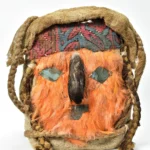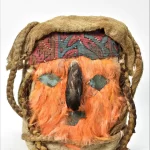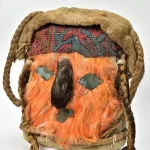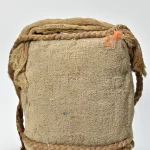Nazca – Huari False Head Feather Mask
Intricate Details and Artistic Narrative of this
Nazca – Huari Feather Mask
In the ancient Americas, skilled craftspeople made luxurious goods restricted for the right and the entitled. Their culture crafted these prized objects for ritual and regalia, using their most valued materials. Jade, rather than gold, was the most precious substance to the Olmecs and the Maya in Mesoamerica, and the Incas and their predecessors in the Andes valued feathers and textiles above all.
This is a rare “Elites” false head feather bundle from the Nazca Huari period. It is a remarkable and delicate mummy, face mask head, comprises Totoro reed stuffed with woven cotton gauze. Small, vibrant orange feathers are attached to the front, creating the face. The nose bundle is in relief, with black feathers applied for contrast. Eyes and mouth are made from copper sheets and sewn in. The crown is composed of two sections. The lower headband is a woven textile with colorful zoomorphic imagery. The upper is a bulky cotton gauze. The braided rope also adorns the entire head.
These “false heads” crowned the bulky funeral bales of an Elite tomb that characterized the time of the Wari/Huari expansion in the territories of the Nazca culture.
Measures 7″ in height, 7″ in width, 3″ in depth.
Southern, Peru. ca. 500 – 1000 AD.
Condition: Some loss of feathers otherwise Choice.
The Nazca-Huari elite false head masks incorporated feathers as a significant symbol of their culture. These feathers connected deeply to the spiritual realm and the natural world, embodying themes of freedom, flight, and divine symbolism within Nazca cosmology. The skilled artisans who crafted these masks used feathers to convey a deeper spiritual meaning and connect the wearer to the transcendent aspects of their belief system.
Price: $5,850 – Domestic Delivery Included
This item may become featured here in the Native American Art Magazine
Click here to see our next item.
Would you be interested in a particular piece? Please feel free to let us know.
Regional Division of Pre-Columbian Americas’ Major Archaeological Cultural Phases





